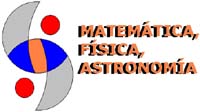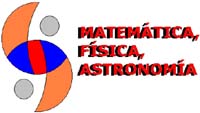
Regresar a la página general de enlaces

BOOTES
BOOTES (Burst Observer and Optical Transient Exploring System), considerado parte de las preparaciones en tierra del satélite INTEGRAL de la Agencia Espacial Europea (ESA) es una colaboración hispano-checa dedicada al estudio de las emisiones ópticas de explosiones de rayos gamma (GRB) que ocurren en el Universo.
BOOTES-IR
BOOTES-IR is the extension of the BOOTES experiment, which has been operating in Southern Spain since 1998, to the near-infrared (nIR). The goal is to follow up the early stage of the gamma ray burst (GRB) afterglow emission in the nIR, as BOOTES does already at optical wavelenghts.
NRAO
National RadioAstronomy Observatory
Founded in 1956, the NRAO provides state-of-the-art radio telescope facilities for use by the international scientific community. NRAO telescopes are open to all astronomers regardless of institutional or national affiliation. Observing time on NRAO telescopes is available on a competitive basis to qualified scientists after evaluation of research proposals on the basis of scientific merit, the capability of the instruments to do the work, and the availability of the telescope during the requested time. NRAO also provides both formal and informal programs in education and public outreach for teachers, students, the general public, and the media.
Red europea de VLBI_The European VLBI Network
The EVN is a collaboration of the major radio astronomical institutes in Europe, Asia and South Africa and performs high angular resolution observations of cosmic radio sources. An overview of the EVN can be found in our Introduction to the EVN. The EVN is a large scale astronomical facility that is open to astronomers from all over Europe and the rest of the world. You can consult the EVN User Guide for help with proposing, scheduling, observing and reducing EVN data.
Página del WMAP
The Wilkinson Microwave Anisotropy Probe (WMAP) is a NASA Explorer mission that launched June 2001 to make fundamental measurements of cosmology -- the study of the properties of our universe as a whole. WMAP has been stunningly successful, producing our new Standard Model of Cosmology. WMAP continues to collect high quality scientific data.
Centro Astronómico Hispano Alemán, Calar Alto
El Observatorio Astronómico Hispano-Alemán de Calar Alto está situado en la Sierra de Los Filabres, norte de Almería (Andalucía, España). Es operado conjuntamente por el Instituto Max-Planck de Astronomía en Heidelberg, Alemania, y el Instituto de Astrofísica de Andalucía (CSIC) en Granada, España. Calar Alto proporciona tres telescopios con aperturas de 1.23m, 2.2m y 3.5m. Un telescopio de 1.5m, también localizado en la montaña, es operado bajo el control del Observatorio de Madrid.
Paranal Observatory Home Page
On Paranal ESO operates the ESO Very Large Telescope (VLT) with four 8.2-m telescopes (the Unit Telescopes or short UTs). Each UT provides one Cassegrain and two Nasmyth focus stations for facility instruments. One Nasmyth focus is available for visitor instruments. In addition each UT is equipped with a Coude focus station from which the light can be coherently combined in the interferometric focus.
Proyecto COROT
COROT, (Convección, Rotación y Tránsitos), es un telescopio espacial pequeño dedicado a fotometría con una precisión extremadamente alta en observaciones de larga duración. El satélite tiene dos objetivos principales a lograr con observaciones en zonas contiguas en el cielo: Astrosismología y Detección de planetas extrasolares.
Departamento de Astrofísica de la Univ. Complutense
Departamento de Astrofísica y Ciencias de la Atmósfera (Física de la Tierra Astronomía y Astrofísica II)
Áreas de conocimiento:
Astronomía y Astrofísica, Código área: 038
Física de la Tierra Código área: 398
Facultad de Ciencias Físicas
Universidad Complutense de Madrid
28040 Madrid, Spain
IRAM
Institut de Radioastronomie Milimetrique.
IRAM operates two major facilities: a 30 meter diameter telescope on Pico Veleta in the Sierra Nevada (Southern Spain), and an array of six 15 meter diameter telescopes on the Plateau de Bure in the French Alps. Besides the two observatories and the headquarters located in Grenoble (France), IRAM operates in Granada a support base for the 30m telescope
VLA
The Very Large Array, one of the world's premier astronomical radio observatories, consists of 27 radio antennas in a Y-shaped configuration on the Plains of San Agustin fifty miles west of Socorro, New Mexico. Each antenna is 25 meters (82 feet) in diameter. The data from the antennas is combined electronically to give the resolution of an antenna 36km (22 miles) across, with the sensitivity of a dish 130 meters (422 feet) in diameter.
Hubble Space Telescope Science Institute
The Space Telescope Science Institute (STScI) -- home of science program selection, grant administration, planning, scheduling, and public outreach activities for the Hubble Space Telescope (HST). STScI provides data archive and distribution for all of NASA's optical/UV missions, including HST. STScI is also the science and operations center for the 6.5m James Webb Space Telescope (JWST). Details on these and other related topics can be found throughout the site.
